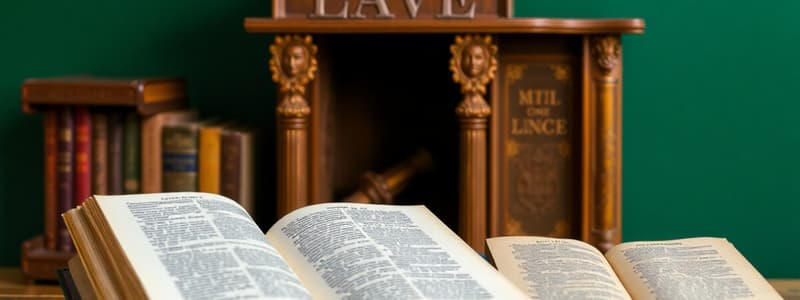Podcast
Questions and Answers
What narrative perspective is typically used in autobiographies as mentioned in the content?
What narrative perspective is typically used in autobiographies as mentioned in the content?
- Third-person narrative
- Omniscient narrative
- Second-person narrative
- First-person narrative (correct)
Which characteristic describes the hero in the novels discussed?
Which characteristic describes the hero in the novels discussed?
- A tragic figure from history
- A wealthy aristocrat
- A realistic, self-made individual (correct)
- A fantastical, mythical figure
What element is noted to enhance the realism of a narrative?
What element is noted to enhance the realism of a narrative?
- Vague descriptions of settings
- Ambiguous character backgrounds
- Chronological sequence of events (correct)
- Complex plot twists
What style is commonly associated with Jonathan Swift's works as mentioned in the content?
What style is commonly associated with Jonathan Swift's works as mentioned in the content?
Which aspect is essential for the characters mentioned to connect with readers?
Which aspect is essential for the characters mentioned to connect with readers?
What was a significant characteristic of the 18th-century Augustan Age?
What was a significant characteristic of the 18th-century Augustan Age?
Which group was primarily responsible for the increase in the reading public during the Augustan Age?
Which group was primarily responsible for the increase in the reading public during the Augustan Age?
What was the aim of early English newspapers like The Tatler and The Spectator?
What was the aim of early English newspapers like The Tatler and The Spectator?
Which factor did NOT contribute to the rise of the novel during the Augustan Age?
Which factor did NOT contribute to the rise of the novel during the Augustan Age?
What role did coffee-houses play in the reading culture of the Augustan Age?
What role did coffee-houses play in the reading culture of the Augustan Age?
Flashcards
The Augustan Age
The Augustan Age
A period characterized by political stability, individualism, liberal thought, optimism for progress, and emphasis on reason, common sense, and balance.
The Rise of the Reading Public
The Rise of the Reading Public
The increase in literacy and reading during the 18th century was driven by factors like the growing importance of the middle class, individuals' trust in their own abilities, and the practice of reason and self-analysis.
The Impact of the Middle Class
The Impact of the Middle Class
The rising middle class, with their growing interest in literature, fueled the development of journalism and the novel.
The Early Newspapers
The Early Newspapers
Signup and view all the flashcards
The Rise of the Novel
The Rise of the Novel
Signup and view all the flashcards
1st-Person Narrator
1st-Person Narrator
Signup and view all the flashcards
3rd-Person Narrator
3rd-Person Narrator
Signup and view all the flashcards
The Hero
The Hero
Signup and view all the flashcards
Setting
Setting
Signup and view all the flashcards
Chronological Sequence of Events
Chronological Sequence of Events
Signup and view all the flashcards
Study Notes
The Rise of the Novel
- The Augustan Age (18th Century): Key concepts included political stability, individualism, liberal thought and free will, optimism, reason, and a desire for balance and symmetry in the arts.
The Reading Public
- Growth of the middle class: The growing importance of the middle class contributed to the increase in the reading public.
- Individual confidence: Individuals increasingly trusted their own abilities and were interested in self-analysis.
- Borrowing and Lending: Middle-class women were frequent readers and borrowed books from lending and circulating libraries.
- Coffee Houses: Coffee houses provided a space for the circulation of news and opinions, further fostering interest in reading.
- Journalism: The rising interest in literature led to the development of journalism.
- The Tatler and The Spectator: These were early English newspapers known for their simple, lively style and didactic aim.
- The rise of the novel: The interest in literature and journalism facilitated the growth of the novel; particularly because readers found the novel related to their experiences.
The Setting
- Chronological Accuracy: Novels used precise chronological details including dates, times of day, and locations (e.g., "I was born in the year 1632, in the city of York").
- Detailed Descriptions: Detailed descriptions of settings and interiors were crucial for making narratives more realistic.
- Specific Place Names: Novels used specific names of countries, towns, and streets to enhance the sense of realism.
The Narrative Technique
- First Person Narration: Authors like Daniel Defoe and Jonathan Swift used first-person narration for fictional autobiographies and accounts of experiences.
- Third Person Narration: Henry Fielding used third-person narration in his novels.
- Patterns: The patterns used by authors included fictional autobiographies, and the mock-epic style.
The Characters
- The Hero: Frequently, the hero was a realistic, bourgeois, self-made, and self-reliant man, with whom readers could sympathize.
- Mouthpiece of the Author: The hero often served as the author's mouthpiece.
- Contemporary Names: Characters often had contemporary names and surnames. (e.g., Robinson Crusoe)
- Character Struggles: Characters often struggled with survival and social success.
The Novelist
- Spokesman of the Middle Class: Novelists often acted as spokespeople for the middle class.
- Founders of the English Novel: Writers like Daniel Defoe and Jonathan Swift were key figures in developing the English novel.
- Defoe: Known for his realistic novels.
- Swift: Famous for his utopian novels.
The Novelist's Aim
- Wide Audience: Novelists aimed to be understood by a wide audience and to that end they wrote their works in a clear and simple way.
- Realistic and Detailed Representation: Realism was prioritized in the novel, meaning the presentation of the story, its characters, and its world had to be realistic.
- Commercial Success: Speed and copiousness were essential traits for attracting booksellers as customers.
Themes
- Real Life: Novels often depicted real-life scenarios and experiences.
- Social Status: Exploring events, experiences, or factors that altered social standing was typical in novels.
- Reward and Punishment: The theme of reward and punishment often reflected the Puritan ethics of the middle class.
Studying That Suits You
Use AI to generate personalized quizzes and flashcards to suit your learning preferences.
Related Documents
Description
Explore the significant developments in literature during the Augustan Age of the 18th century. This quiz covers themes such as the growth of the middle class, the rise of individualism, and the impact of coffee houses and journalism on the reading public. Test your understanding of these key concepts and their influence on the novel.



